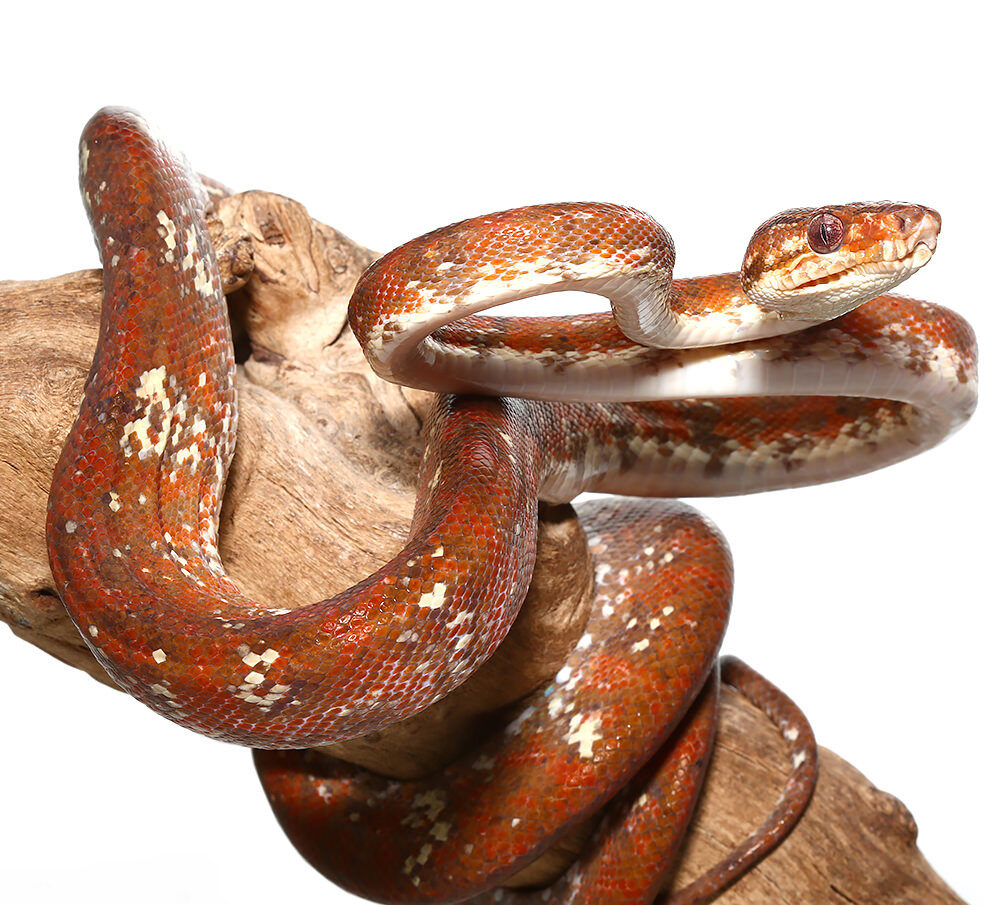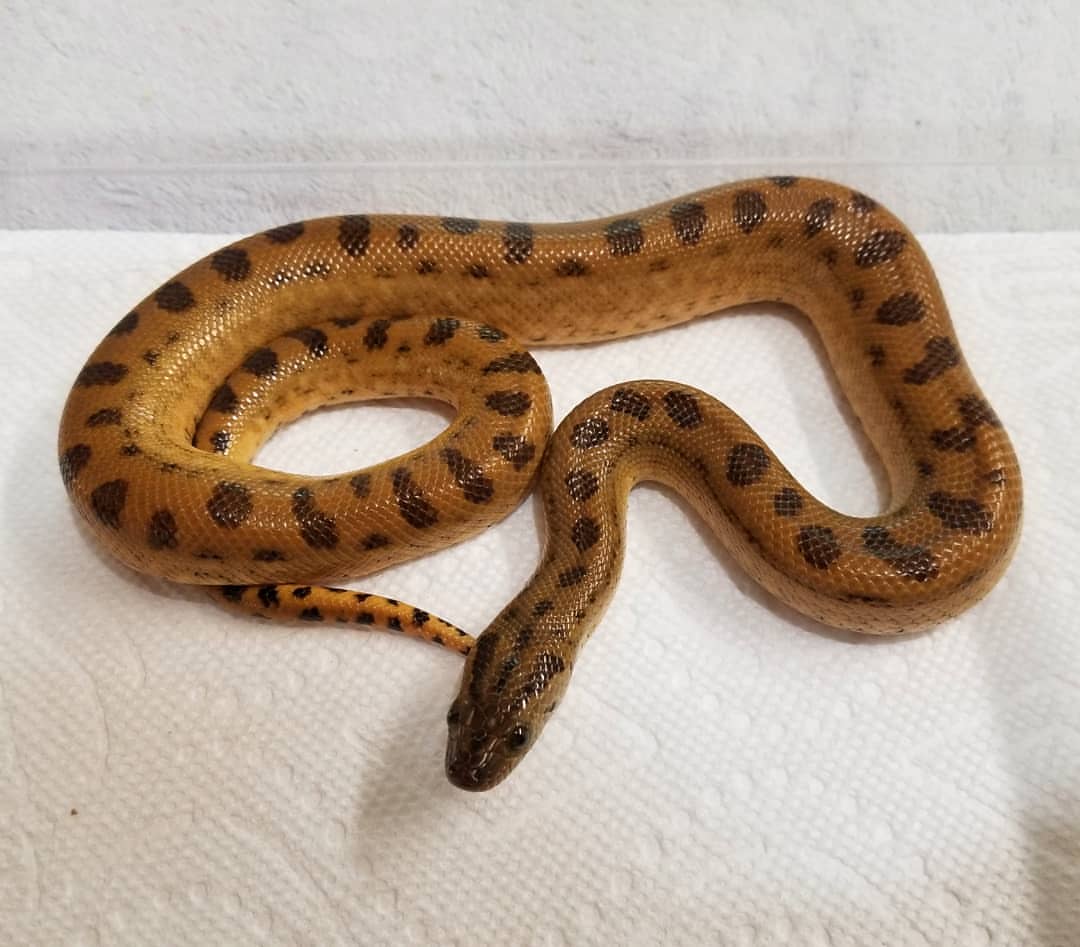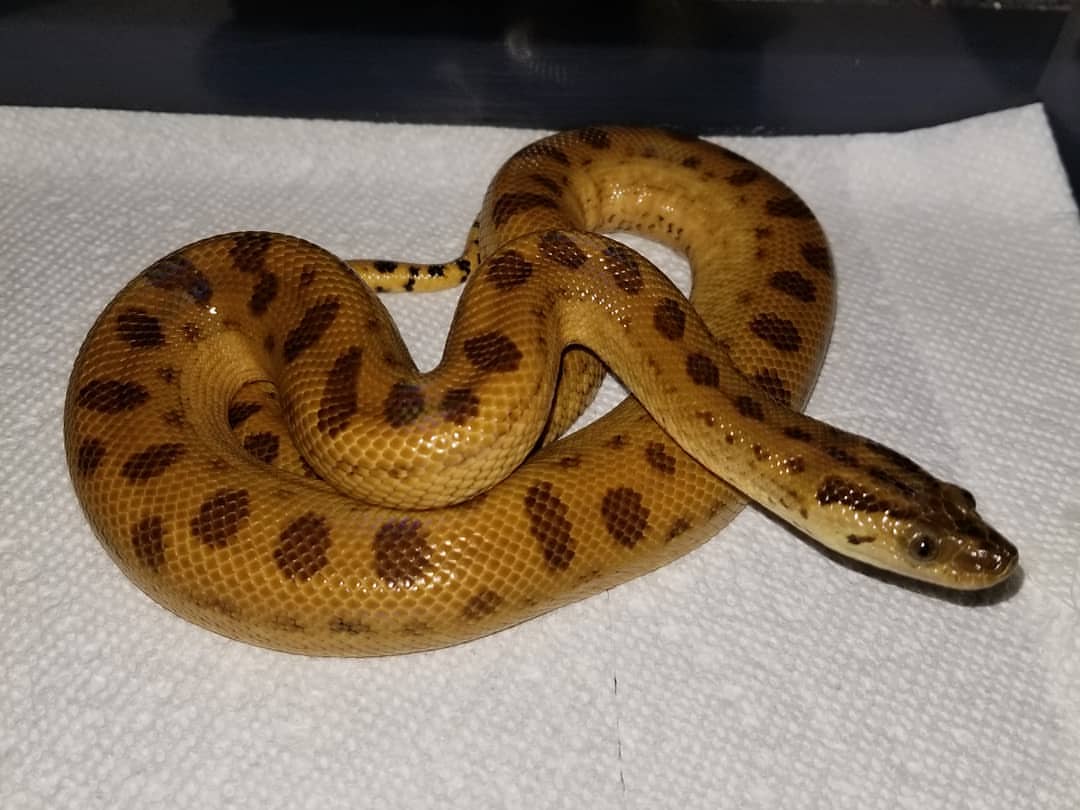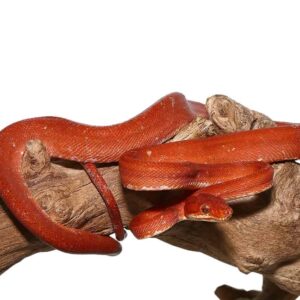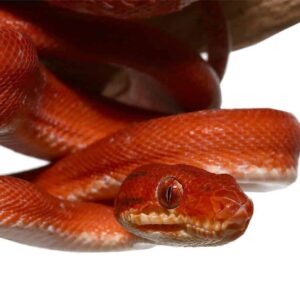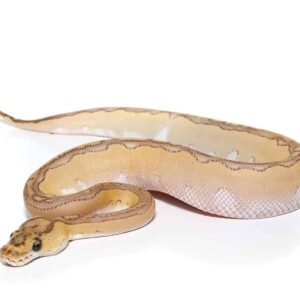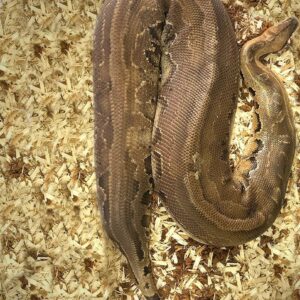Yellow Anaconda For Sale
$750.00
( Eunectes notaeus ) also known as the Paraguayan anaconda is a boa species native in south South America. It is among the largest snakes on the planet however it is smaller than its closest counterpart that is which is the the green anaconda. As with all boas and Pythons they are unvenomous and kills prey via constriction. It is not known if it is a subspecies.
Habits and Lifestyle
Yellow anacondas are snakes that are active throughout the day as well as at night. They live their entire time in or near the water, and are often referred to in the form of “Water boas”. In water, anacondas typically sit on top of the water having their noses just peeking out of the water’s surface.
While the majority all their lives are spent within water ecosystems Yellow Anacondas will venture out onto land to travel to different water bodiesto hunt prey on land and mating. They hunt primarily in the shallows of wetland habitats, using ambush predation and broad-foraging strategies.
Furthermore,
Predation is most prevalent in the months of June through November when the floods have diminished while wading birds constitute among the main prey. Snakes that are shy and will usually attempt to escape predators, but if they are threatened, they’ll protect themselves.
GROUP NAME
den nest, pit knot, bed
LIFESTYLE
Terrestrial, Ambush predator, Precocial, Arboreal,
SEASONAL BEHAVIOR
Not a migrant
Diet and nutrition
Carnivores are yellow anacondas. Their food source is largely of semi-aquatic and aquatic species, which includes a vast assortment of birds, mammals reptiles, amphibians, reptiles eggs, and fish. Larger animals can prey on larger animals, like Brocket capsybaras or deer, or peccaries.
DIET Carnivore
Habits of Mating
REPRODUCTION Season
April-May
PREGNANCY DURATION
6 months
BABY CARRYING
4-82 young
INDEPENDENT AGE
at the time of birth
Name of the female
Female
MALE NAME
Male
BABY NAME
snakelet
More so,
It isn’t much known about mating in Yellow Anacondas. They are ovoviviparous, and give the birth of live babies. They usually reproduce between April between April and May. In this period, females release Pheromones that attract males.
The courtship typically takes place in the water. Yellow anacondas could form breeding ballsthat consist of a female and several males. They can remain with each other for up to one month. Males fight for the females’ attention, and the most powerful and largest male will mate with females.
hence,
Females have 4-82 babies after the gestation period which lasts for about six months. After baby, mother gives up her children and they become capable of living independently. Yellow anacondas are mature reproductively when they reach 3-4 years of age.
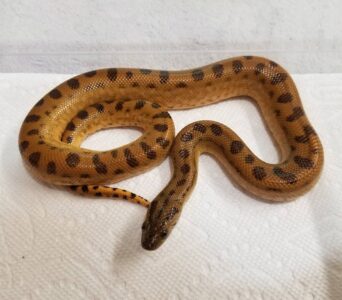
Description
The yellow anaconda, scientifically known as Eunectes notaeus, is a captivating species within the boa family. Renowned for its vibrant coloration, this anaconda stands out with its yellow to greenish-yellow body adorned with black or dark brown blotches and rosettes. This distinctive pattern not only aids in camouflage within its natural habitat but also sets it apart from its more famous relative, the green anaconda.
On average, the yellow anaconda measures between 10 to 13 feet in length, though some individuals can grow even larger. This makes them relatively smaller compared to the colossal green anaconda. However, their size does not diminish their impressive presence in the wild. Their robust build and muscular physique enable them to be formidable predators within their ecosystems, primarily inhabiting the swamps, marshes, and rivers of South America, particularly in countries like Paraguay, Brazil, and Argentina.
One of the most striking features of the yellow anaconda is its ability to blend seamlessly into its aquatic and semi-aquatic environments. Their coloration and physical adaptations make them highly efficient hunters, capable of ambushing prey with precision. They primarily feed on a diet of fish, birds, and small mammals, contributing significantly to controlling the population of these species and maintaining ecological balance.
The yellow anaconda’s ecological significance extends beyond its role as a predator. It serves as a crucial indicator of environmental health. The presence and population trends of yellow anacondas can provide valuable insights into the condition of their habitats, signaling changes in water quality and ecosystem stability. This makes them an important subject for scientific study and conservation efforts.
Understanding the yellow anaconda enhances our appreciation of biodiversity and the intricate web of life in which these remarkable reptiles play a part. Their unique attributes and ecological contributions make them a fascinating topic for herpetologists and nature enthusiasts alike, inviting further exploration into their behaviors and habitats.
Habitat and Distribution
The yellow anaconda (Eunectes notaeus) is predominantly found in the subtropical and tropical regions of South America. Its distribution spans across several countries, including Brazil, Paraguay, and Argentina. These regions provide the ideal environmental conditions that support the survival and proliferation of this remarkable species.
Yellow anacondas exhibit a strong preference for aquatic habitats, thriving in areas such as swamps, marshes, and slow-moving rivers. The abundance of water bodies in their natural range offers ample opportunities for hunting and camouflage. These snakes are adept swimmers and often immerse themselves in the water to ambush prey, utilizing their expert stealth and opportunistic hunting strategies.
The choice of habitat directly influences the behavior and survival strategies of the yellow anaconda. In aquatic environments, they can effectively regulate their body temperature, avoid predators, and access diverse food sources. The dense vegetation and murky waters of swamps and marshes provide excellent cover, allowing these snakes to remain concealed while waiting for unsuspecting prey.
Moreover, the slow-moving rivers and wetlands support a rich biodiversity, supplying the yellow anaconda with a varied diet that includes fish, birds, amphibians, and small mammals. Their semi-aquatic nature also aids in thermoregulation, as they can bask on the banks or submerge themselves to cool down, maintaining an optimal body temperature.
Overall, the specific habitat requirements of the yellow anaconda underscore the intricate relationship between the species and its environment. The availability of aquatic ecosystems not only shapes their physical adaptations but also dictates their behavioral patterns, ensuring their continued survival in the lush and biodiverse landscapes of South America.
Diet and Hunting Techniques
The yellow anaconda, native to the wetlands of South America, exhibits a diverse diet that primarily includes fish, birds, mammals, and occasionally other reptiles. Its opportunistic feeding habits allow it to adapt to the availability of prey within its environment. Fish are a significant component of its diet, particularly during the wet season when aquatic prey is abundant. The anaconda’s proficiency in swimming aids in capturing these slippery targets with remarkable efficiency.
Birds also constitute an essential part of the yellow anaconda’s diet. Utilizing its stealth and ambush tactics, the anaconda often lies in wait along the water’s edge or in dense vegetation, striking when an unsuspecting bird comes within reach. These ambush techniques are a hallmark of the anaconda’s hunting strategy, allowing it to conserve energy while maximizing the chance of a successful catch.
Mammals, ranging from small rodents to larger animals like capybaras, are another vital food source. The yellow anaconda employs its signature constriction method to subdue these prey. Once captured, the anaconda coils its muscular body around the prey, tightening its grip with each exhalation of the prey until suffocation occurs. This powerful method ensures that even larger, more robust animals cannot escape.
Seasonal variations significantly influence the yellow anaconda’s diet. During the dry season, when water sources recede, and aquatic prey becomes scarce, the anaconda may shift its focus more towards terrestrial prey. This adaptability not only aids its survival but also impacts the local ecosystem by controlling the population of various species.
The feeding habits of the yellow anaconda play a crucial role in maintaining ecological balance. By preying on a variety of animals, it helps regulate populations and supports the health of its habitat. Understanding these dynamics provides insight into the intricate relationships within the ecosystem and highlights the importance of the yellow anaconda in its natural environment.
Reproduction and Life Cycle
The reproductive behaviors of the yellow anaconda (Eunectes notaeus) are intricate and captivating. The breeding season typically occurs during the warmer months, from April to May, when the environmental conditions are most conducive to successful reproduction. During this period, male yellow anacondas engage in an elaborate courtship ritual, often competing for the attention of a receptive female. This process can involve multiple males coiling around a single female in what is known as a breeding ball, a behavior observed in various snake species.
Once mating has occurred, the female yellow anaconda enters a gestation period that lasts approximately six months. Unlike many snakes that lay eggs, yellow anacondas are ovoviviparous, meaning they give birth to live young. This adaptation is particularly advantageous in their aquatic habitats, where eggs could be more vulnerable to predation and environmental fluctuations. When the gestation period concludes, the female gives birth to a litter of around 20 to 40 offspring, though the number can vary based on the female’s size and health.
Newborn yellow anacondas are relatively independent and must fend for themselves from birth. They measure about 60 to 70 centimeters in length and immediately begin their life in the challenging wetlands and riverine environments. The juvenile stage is fraught with peril, as young anacondas are susceptible to predation by birds, larger reptiles, and even their own kind. Survival to adulthood requires a combination of stealth, adaptability, and access to ample food sources.
The growth stages from juvenile to adulthood span several years. During this time, yellow anacondas undergo numerous molts, shedding their skin as they grow. This process is crucial for their development and overall health. Adulthood is typically reached when the snakes are about three to four years old, with females generally requiring more time to mature than males. Reaching adulthood marks the beginning of their reproductive capabilities, thus continuing the cycle of life for this remarkable species.
Behavior and Social Structure
The yellow anaconda, also known as Eunectes notaeus, is renowned for its predominantly solitary nature. Unlike many other species that may form large groupings or social structures, the yellow anaconda tends to lead an independent lifestyle. This solitary behavior is particularly evident in adults, who are often found occupying distinct territories. These territories are usually defended vigorously through a combination of physical displays and, when necessary, combat. The demarcation of territory is crucial for ensuring access to vital resources such as food and basking sites.
Interactions with other anacondas are generally limited to the breeding season, when males actively seek out females. During this period, multiple males may compete for a single female, leading to intense wrestling matches. Despite these competitive interactions, yellow anacondas usually avoid unnecessary conflicts, opting instead to maintain clear boundaries.
Yellow anacondas exhibit several unique behaviors that are well-adapted to their semi-aquatic environments. Basking is a common activity, particularly in cooler months, where they can be found sunning themselves on riverbanks or floating vegetation to regulate their body temperature. This behavior is essential for their metabolism and overall health.
Their proficiency in swimming is another notable characteristic. Yellow anacondas are excellent swimmers, capable of moving swiftly and gracefully through water. This skill not only aids in hunting but also in evading predators. When threatened, their primary defensive mechanisms include retreating to water, where they can remain submerged for extended periods, and utilizing their powerful constrictive abilities if cornered.
Interactions with other species are typically driven by predatory or defensive needs. Yellow anacondas prey on a variety of animals, including fish, birds, and small mammals, showcasing their adaptability as opportunistic hunters. Conversely, they must navigate the threat of larger predators, employing camouflage and their aquatic prowess to stay safe.
Threats and Conservation Status
The yellow anaconda (Eunectes notaeus) is currently categorized under the “Least Concern” status according to the International Union for Conservation of Nature (IUCN). However, this classification does not imply that the species is free from threats. Habitat destruction is a significant concern for yellow anacondas, particularly due to deforestation and wetland drainage driven by agricultural expansion. The alteration of natural habitats disrupts the ecological balance and reduces the availability of prey, adversely affecting the species’ population.
Climate change presents another formidable threat to the yellow anaconda. Shifts in temperature and precipitation patterns can lead to habitat degradation, altering the ecosystems these snakes rely on. Changes in water levels in their marshy habitats can impact breeding patterns and reduce the availability of suitable areas for these semi-aquatic reptiles to thrive.
Human activities pose direct threats as well. The yellow anaconda is often hunted for its skin, which is highly valued in the leather industry. This illegal trade, coupled with indiscriminate killing due to fear or misunderstanding of the species, further endangers their numbers. Additionally, the pet trade can lead to illegal capture and sale, contributing to population declines in the wild.
Efforts to protect and conserve the yellow anaconda are multifaceted. Legal protections are in place in several countries within its range. For example, in Argentina and Brazil, national laws regulate hunting and trade, aiming to curb illegal activities. Conservation programs are also being implemented to preserve natural habitats and mitigate the impacts of climate change. These initiatives often involve collaboration between governmental bodies, non-governmental organizations, and local communities to promote sustainable practices and raise awareness about the ecological importance of the yellow anaconda.
In conclusion, while the yellow anaconda is not currently considered at immediate risk of extinction, ongoing conservation efforts are essential to ensure its long-term survival. By addressing habitat destruction, climate change, and illegal hunting, we can help safeguard this fascinating species for future generations.
Yellow Anaconda in Captivity
The yellow anaconda (Eunectes notaeus) is a species frequently found in zoos and private collections around the world. Their striking appearance and impressive size make them a captivating exhibit in zoological parks, where they often serve as ambassadors for their species, helping to educate the public about their natural habitat and behavior. However, the challenges and ethical considerations of keeping yellow anacondas in captivity are substantial and require careful thought and planning.
One of the primary challenges of housing yellow anacondas in captivity is recreating an environment that meets their physical and psychological needs. An appropriate enclosure should be spacious, allowing the snake ample room to move, swim, and explore. The enclosure must be equipped with a water feature, as yellow anacondas are semi-aquatic and spend a significant amount of time in water. The enclosure should also have regulated temperature and humidity levels, mimicking the warm, humid conditions of their natural habitats in South America.
Dietary needs of captive yellow anacondas are another critical aspect of their care. In the wild, they are opportunistic feeders, consuming a variety of prey such as fish, birds, and small mammals. In captivity, they typically require a diet of appropriately sized rodents or rabbits, provided at regular intervals. It is essential to monitor their feeding to prevent overfeeding, which can lead to obesity and other health issues.
Ethical considerations also play a significant role in the decision to keep yellow anacondas in captivity. These snakes are known for their strong, muscular bodies and potentially aggressive behavior, which can pose risks to inexperienced handlers. Ensuring that caretakers are adequately trained and knowledgeable about the specific needs and behaviors of yellow anacondas is crucial for both the safety of the animals and their handlers. Moreover, the ethical implications of removing these creatures from their natural habitats must be carefully weighed against the benefits of captive breeding programs aimed at conservation and education.
Notable cases, such as the long-term study conducted at the Philadelphia Zoo, have provided insights into the care and behavior of captive yellow anacondas. These studies highlight the importance of environmental enrichment, proper nutrition, and regular health checks to maintain the well-being of these fascinating reptiles in captivity. Through informed and ethical practices, the captivity of yellow anacondas can contribute to their conservation and the broader understanding of their species.
Cultural Significance and Misconceptions
The yellow anaconda holds a notable place in the cultural tapestry of regions where it is native, particularly in South America. In local folklore, the anaconda is often revered as a powerful and mystical creature. Stories abound of its immense strength and elusive nature, symbolizing both fear and respect. Such narratives have been handed down through generations, contributing to the yellow anaconda’s enigmatic reputation.
In popular media, the yellow anaconda frequently features as a subject of fascination and intrigue. Documentaries and films often portray it as a formidable predator, sometimes amplifying its characteristics to create a sense of drama. While these portrayals capture the imagination, they can also perpetuate certain myths and misconceptions. For instance, the yellow anaconda is often depicted as aggressively dangerous to humans, which is a significant exaggeration. In reality, instances of yellow anacondas attacking humans are exceedingly rare, as these snakes tend to avoid human contact whenever possible.
Addressing these misconceptions is pivotal for fostering a balanced understanding of the yellow anaconda. Educational programs and initiatives have been instrumental in this regard. Conservation organizations and wildlife educators strive to demystify the yellow anaconda by providing factual information about its behavior, habitat, and ecological importance. These efforts are crucial in dispelling myths and promoting a respectful coexistence between humans and this remarkable species.
Moreover, media campaigns and documentaries that focus on the yellow anaconda’s role in the ecosystem help to shift public perception. By highlighting the snake’s contribution to controlling pest populations and maintaining ecological balance, such initiatives underscore the importance of preserving its natural habitat. Interactive exhibits in zoos and wildlife sanctuaries also play a significant role in educating the public, offering firsthand experiences that foster a deeper appreciation for the yellow anaconda.

